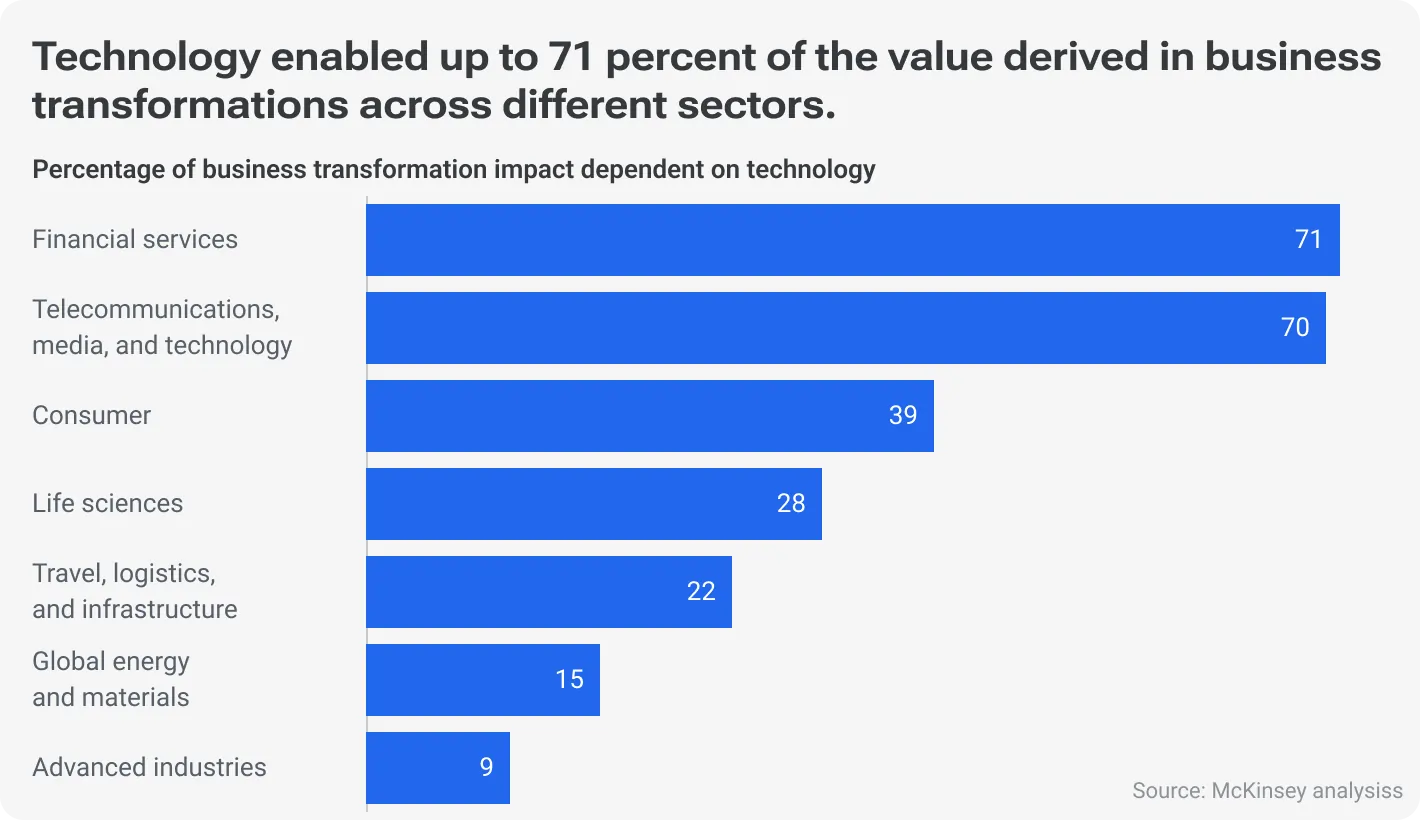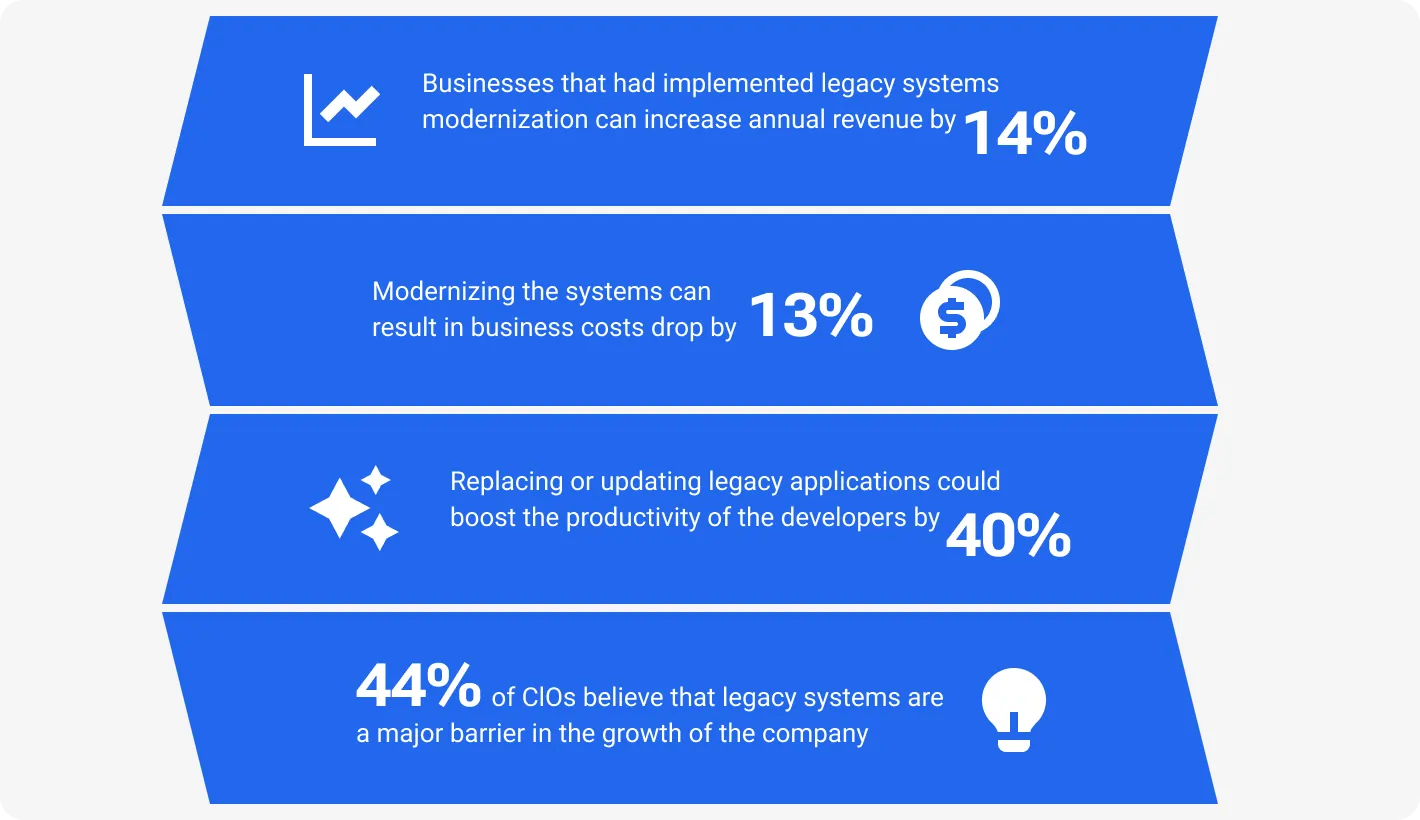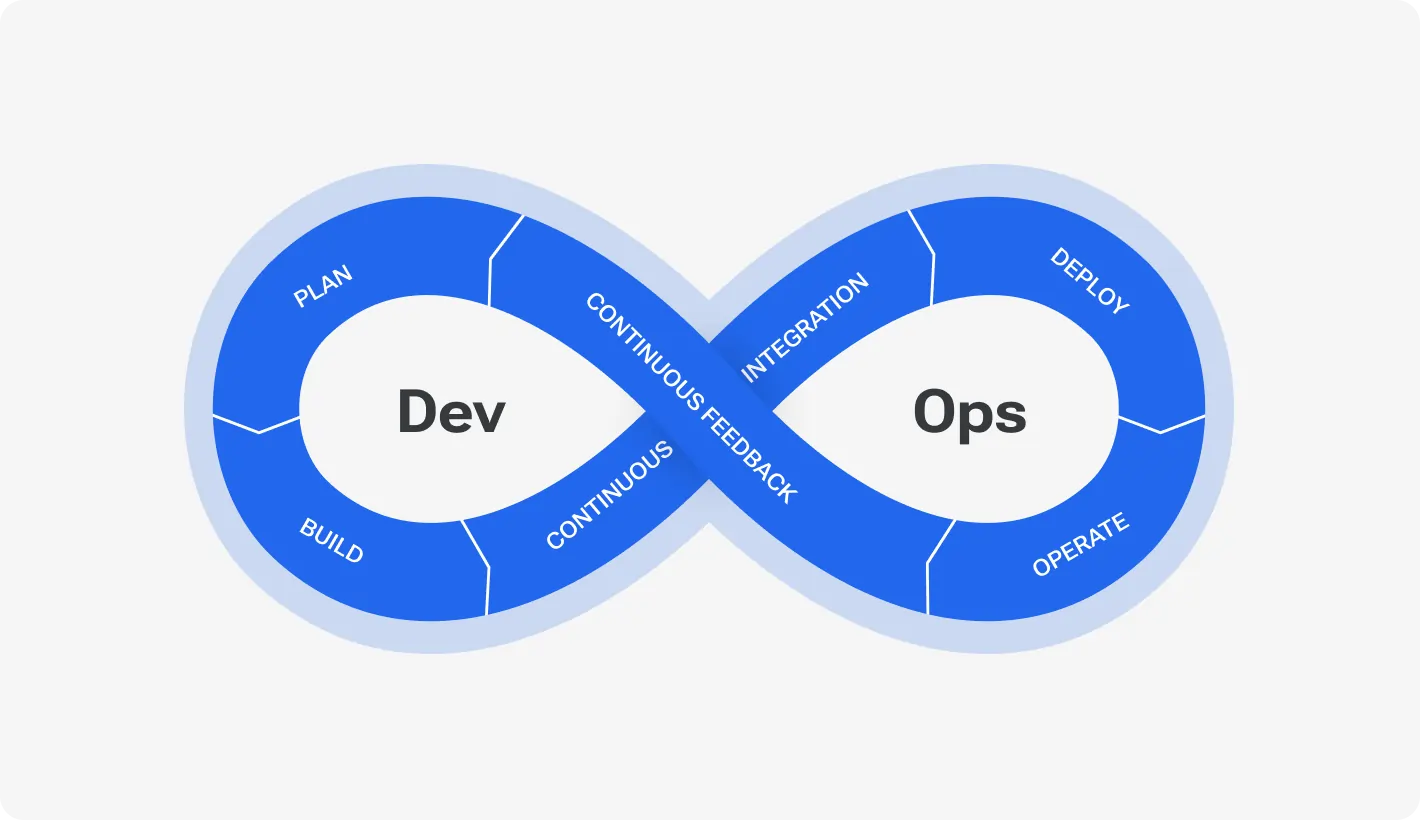Nowadays, businesses often find themselves grappling, trying to reduce technical debt. McKinsey states that almost any SME has 20 to 40% of this hidden burden. Outdated code, inefficient infrastructure, and neglected documentation weigh down progress. This tech debt is a vicious cycle that shackles growth, stifles innovation, and threatens the very foundation of the business.
Very similar to a poorly maintained machine. Each patch, quick-fix, and workaround adds another layer of rust, grinding gears and dragging down performance. This is the impact of technical debt.
But there's a silver lining. Only by embracing modernization business can ensure a bright future. Another McKinsey study shows that 71% of SMEs’ modernization hinges on technology advancements.
Like gym progress, real technology advancement happens with slow but persistent steps. Rush development accumulates a burden that slows down progress. This cycle of accumulating debt not only inhibits the ability to respond to market changes swiftly but also erodes the foundation for future innovation.
The link between modernization efforts and sustainable business success is undeniable. In a landscape where technological evolution is constant, businesses that fail to modernize risk becoming obsolete. But well, there is an app for that.
Definition of Technical Debt
Let’s clarify technology debt (aka code debt or TD) by three simple examples.
Recall your university years. How did it feel when you encountered a tricky task during the exam? Let’s face it, there was a powerful temptation to cheat or at least to cut corners. In some senses, technical debt is like taking such a shortcut when building something.
Alternative comparison: imagine you're constructing a treehouse for kids. Children are screaming and demanding the house be delivered as soon as yesterday. So you decided to replace the sturdiest materials and safety double-checking with the quickest ones to finish faster. It might work for a while, but over time, you realize the treehouse has become a hazard to kids since it may simply collapse.
This kind of thing is happening all over the place in the digital business. Technical debt is akin to the mentioned shortcuts — quick solutions that accumulate and create challenges in the long run. Like once was said, simple decisions — hard life; hard decisions — easy life.
And the most popular analogy is based on the financial comparison. Just like financial debt, code debt involves borrowing from the future. Choosing expedience over thoroughness creates a debt that must be repaid eventually, impacting the overall health of the project.
Technical debt examples and how to solve them
The Vicious Cycle of Technical Debt
Have you ever taken part in the Spartan Race or Iron Man? Some such races involve running cross-country or even in a swamp. That is, with each step, you seem to be getting closer to the finish line, but in reality, you only get stuck and lose steam.
Perhaps the comparison is a bit weird, but it illustrates well the impact of technical debt. This is its vicious cycle, an insidious force that gradually tightens its grip on your business. Before you grip tech debt reduction, you must understand how it operates.

Short-Term Gain, Long-Term Strain: When the CTO and CEO create a high-pressing atmosphere, developers might choose expedient solutions that offer short-term gains. These decisions obviously meet immediate deadlines, but in the long run, they simply don’t work.
Tax of Debt: Each shortcut or hasty decision adds to the technical debt. This accumulated debt becomes a burden that slows down future development efforts and makes the whole system more complex. This is like a hidden tax on your development team. Time spent deciphering outdated code, navigating labyrinthine architectures, and tackling bugs bleed into their productivity. As a consequence, you end up with missed deadlines, delayed features, and, hence, frustrated customers.
Reduced Agility and Adaptability: There is no more dangerous foe for the agility of your dev team than code debt. As it mounts, the agility drastically diminishes. Responding to market changes or introducing new features becomes increasingly cumbersome.
Inhibited Innovation: Every bug fix, workaround, and outdated dependency saps precious development resources. You don't think about innovation anymore. You just need to deal with the current situation. Like when a barge sinks, you don't think about conquering new lands, you try to keep up with the flow of water that needs to be shoveled out. Such an innovation deficit leaves your business vulnerable to nimble competitors who embrace new technologies and outpace you in the market.
Security Vulnerabilities: Cracks in your software, unpatched vulnerabilities, and weak encryption points are open doors for cyberattacks. 23andMe, Samsung, and other reputable companies don’t allow us to trick you — security is no.1 to every business in 2025. Data breaches, reputational damage, and financial losses — all potential consequences of neglecting your technical debt's security risks.
Repetition of the Cycle: Without a concerted effort to break the cycle, the pattern repeats. Short-term decisions breed long-term consequences, perpetuating a cycle that erodes the foundation for sustained growth.
Importance of Modernization for Business Growth
Time to market is overrated. Delivery time is overrated. Modernization efforts are underrated. And the correlation between them cannot be overstated. You may think of modernization as just keeping up with the latest trends. It’s not quite true. Modernization it’s rather a weapon that takes aim at the vicious cycle head-on.
In general, all benefits and important points of modernization are opposite to code debt’s ruses. But let’s break down them to make it more clear.
Adaptability to Market Changes: Nowadays, almost every market is a fast-changed one. The ability to adapt swiftly is a competitive advantage. Modernization ensures that a business's technological infrastructure is agile enough to respond promptly to shifting market dynamics, consumer preferences, and emerging trends. You probably feel it after OpenAI’s release of ChatGPT.
Enhanced Operational Efficiency: Outdated systems and accumulated technical debt can impede operational efficiency. Modernizing processes and technologies streamlines operations, reduces bottlenecks, and enhances overall efficiency. This, in turn, allows resources to be allocated strategically for maximum impact.
Unlocking Innovation Potential: You have two choices: direct resources toward innovation or toward grappling with code debt. By addressing and mitigating TD through modernization, businesses create a conducive environment for innovation. This is particularly vital in healthcare, edtech, and martech industries, where staying ahead of the curve is synonymous with success.
Improving Customer Experience: Customer is king. Their experience with your product or service is queen. Modernization efforts directly impact the customer experience. Convenient app, lightning-fast website, detailed info in client portal to minimize support staff workload — all that makes a difference. Up-to-date systems enable businesses to provide seamless and innovative solutions, enhancing customer satisfaction and loyalty.
One and Only or Fall Behind: In a landscape where disruptors and innovators abound, staying competitive requires more than just maintaining the status quo. Businesses that prioritize modernization position themselves to not only keep up with the competition but also lead the way in their respective industries.
Wield these moves, and you will be able to transform your business from a debt-ridden battlefield into a well-balanced and well-tuned mechanism.
Empower your IT team to focus on innovation and growth by outsourcing your technical debt management
Breaking the Vicious Cycle
You may ask how to reduce technical debt. Well, there are some measures. Let's explore practical strategies for breaking free from the vicious cycle of technical debt.
Conducting a Technical Debt Assessment
Identifying Debt Components: Many businesses lose their bearings when start technical debt reduction. They should begin by conducting a comprehensive technical debt assessment. Identify the specific components contributing to the debt — whether it's outdated technology, legacy code, or insufficient documentation. It is the first step toward reducing technical debt.
Assessing Severity and Impact: Not all technical debt is created equal. Assess the severity and impact of each identified debt component. Prioritize those with the highest potential to impede progress or incur additional costs if left unaddressed.
High-impact, Low-effort: These vulnerabilities deliver a significant punch with minimal investment to fix. Think of a security flaw easily patched, offering substantial risk reduction for minimal effort.
High-impact, High-effort: These issues demand more resources but promise substantial returns. Like a legacy system overhaul delivering long-term performance gains at a higher initial cost.
Low-impact, Low-effort: While seemingly inconsequential, these quick wins can build momentum and foster a culture of improvement. Recall eliminating duplicated code and improving code readability for easier maintenance.
Low-impact, High-effort: These may require careful evaluation. While the payoff might be smaller, addressing them can avoid future cascading failures, like clearing minor blockages to prevent a dam break.
Prioritizing Debt for Resolution
Critical vs. Non-Critical Debt: Create separate cohorts with different types of technical debt, taking its criticality as a basic criterion. Critical debt may directly impact operations, customer experience, or security. Prioritize resolving critical debt first to mitigate immediate risks.
Long-term vs. Short-term Gains: Now, you can assess the nature of debt in terms of long-term and short-term gains. Note, sometimes it’s really better to postpone fast results and sacrifice them for future success. But sometimes not. The context and business goals are better advisers in this case.
Tools for Informed Decision-Making:
Risk Matrices: Plot the severity and urgency of each debt component to prioritize effectively.
Cost-Benefit Analysis: Quantify the financial impacts of different remediation options for informed resource allocation.
Kanban Boards: Visualize your workflow, track progress, and adapt priorities as needed.
The prioritization framework allows you to transform your technical debt from a daunting burden into a manageable roadmap for progress.
Allocating Resources for Modernization
Financial Investment: Modernization requires financial commitment. Your budgetary allocation must align with the overall business strategy and goals. Of course, it’s not easy to spend money on matters that don’t promise fast returns. But look at the root — the long-term benefits of modernization will be your return on investment.
As proof: Accenture surveyed over 1,000 C-suite US executives and found out that companies that spared no expense on modernization saved 15%+ of maintenance costs.
Skilled Workforce: Imagine you are a football coach, and you have a team of amateurs. Without tactic sessions, gym sessions, and training in general, chances are you are not going to win anything. So, invest in training and upskilling programs for your team. This way, everyone wins: you get a skilled team able to address modernization challenges, and your team grows as professionals.
Who should you level up promptly:
Software engineers: Individuals with experience in modern technologies and methodologies.
DevOps experts: Serve as a bridge between development and operations.
Cloud architects: Kind of visionaries who design and implement scalable, secure cloud infrastructure.
Change management specialists: In turbulent times, such specialists will ensure a safe harbor. At least they'll be able to weather the storm.
Establishing a Culture of Continuous Improvement
Be Straightforward and Sincere: Strive for open communication within the entire company. Encourage devs to share insights, concerns, and suggestions related to technical debt. Allow non-tech specialists to take part in brainstorming on overcoming business challenges. This transparency is foundational for effective resolution. Do away with closed structure and yes-sayers in your team. It’s a way to nowhere.
Promote Collaborative Development Practices: Look back at the football team example. Like smooth combinations ensure taking apart a rival’s defense, collaboration between devs is key to breaking the cycle of technical debt. Leverage pair programming and cross-functional team interactions to enhance knowledge sharing and collective problem-solving.
Succeed? Celebrate! And Share Lessons: It’s all about sharing “sunshine” and lessons learned. Recognize little wins, reward progress, and openly discuss challenges. Establish study hours, tech hours, or whatever hours where every motivated specialist and leader can share their most valuable practices and hacks to reduce technical debt. Create a learning loop where knowledge flows freely and informs future endeavors.
Strategies for Successful Modernization
You set up a grand vision and set out your first movements toward your tech freedom. Yet, it demands action through targeted strategies. Let’s outline actionable tactics for C-suite executives to path towards a debt-free, next-level future.
Incremental Refactoring
Breaking Down Large Tasks: Rather than tackling technical debt as an overwhelming monolith, break down large tasks into manageable chunks. Incremental refactoring allows for targeted improvements without disrupting the entire system, minimizing risks and ensuring a smoother transition.
Continuous Integration and Deployment: We’ve already written about DevOps advantages and, among others, mentioned CI/CD nuances. So we just want to make a point that implementing such practices streamlines integrating code changes. This enhances collaboration and enables rapid and reliable releases. Along the way, you seed a culture of continuous improvement. A bit more hints:
Automate integration and testing processes to catch regressions early and ensure consistency.
Implement frequent, low-risk deployments to deliver value incrementally and minimize disruption.
Leverage CI/CD pipelines to streamline and accelerate the refactoring process.
Embracing New Technologies
Cloud Computing: Moving over to cloud computing unlocks scalability, flexibility, and cost-efficiency. Cloud solutions provide the infrastructure needed to support modern, data-driven applications and facilitate a more dynamic and responsive IT environment.
Leverage cloud-native services like serverless functions and managed databases to reduce operational overhead.
Use cloud-based development and collaboration tools (Google Workspace, Microsoft 365, Microsoft Azure, AWS, etc.) to tune the team’s agility and communication.
Microservices Architecture: Embracing a microservices architecture allows for the modularization of applications. This tremendously improves scalability and enables teams to work independently on different components. Such a move reduces dependencies and accelerates development cycles.
Deconstruct your monolithic system into independent, loosely coupled microservices.
This fosters faster development and deployment cycles, greater resilience, and improved maintainability.
Make sure to use containerization technologies like Docker and Kubernetes for seamless microservice management.
Investing in Training and Development
Skill Enhancement Programs: Your team is the most important asset you have. Build trust and make your employees brand advocates through sincere care and opening new opportunities to them. Since modernization efforts are only as effective as the skills of the workforce implementing them. So, invest heavily in skill-boosting programs to ensure that your development team is well-equipped.
Knowledge Transfer Initiatives: Facilitate knowledge transfer within the organization. This role can be played by those “whatever hours” (webinars or live events) we mentioned before. Also, you can create forums for experienced developers to share insights and mentor others. This collaborative approach ensures that the organization as a whole grows in its ability to manage and prevent technical debt.
To sum it up
Even if you understand all the significance of tech debt reduction, it’s not sufficient just carve out 15% of the IT budget for such an initiative. Instead, make a strong connection between each dollar spent on addressing code debt and specific KPIs and business outcomes.
Technology debt isn't just a technical issue; it's a strategic one. The cost of inaction is too high. Businesses that cling to outdated systems risk falling behind agile competitors, missing market opportunities, and ultimately stifling growth. And it’s nothing to say about banal failure in conquering the market.
Modernization is all about building a resilient, adaptable infrastructure that supports your long-term goals. It's about empowering your teams to innovate, deliver value faster, and thrive in the face of change.
However, you won't be able to get away with a one-off action. Embrace a proactive approach. Foster a culture of continuous improvement where technology evolves alongside your business needs. Invest in your team's skills, encourage experimentation, and celebrate progress along the way.
Gain an access to seasoned professionals specialized in managing technical debt







